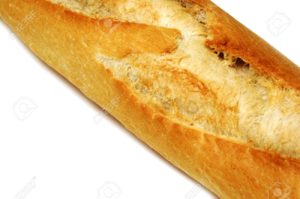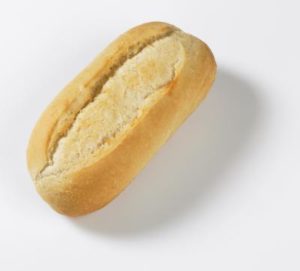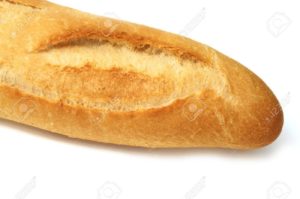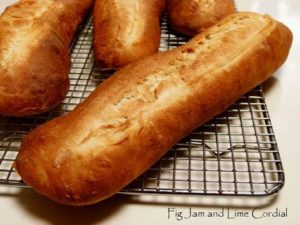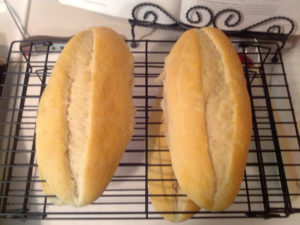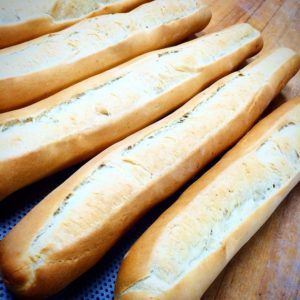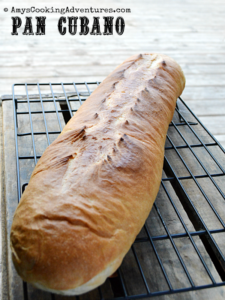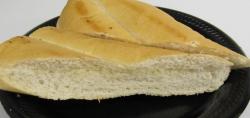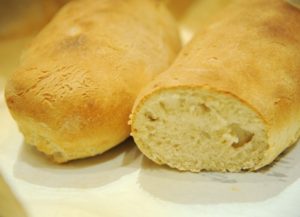Baking bread, any kind of bread, is truly an art. Baking a perfect bakery-quality loaf of Cuban bread is the ultimate accomplishment for any home bread baker. On the surface, Cuban bread seems so simple; it consists of just five main ingredients: flour, water, yeast, lard, and salt.
The challenge, however, is putting these simple ingredients together in exactly the right way. The goal is to create a loaf with a crisp crust on the outside and an airy, lightly textured inside.
The key to baking a great loaf of Cuban bread is in knowing exactly how much flour to use to bring the dough to the perfect consistency. Too much flour, and the bread will be too dense. Too little flour, and the dough won’t rise properly, resulting in a very wide, flat loaf of bread!
If you don’t mind a challenge, the quest for that perfect loaf of Cuban bread can be very rewarding.
With a crisp crust on the outside and a lightly textured inside, a warm, fresh-baked loaf of Cuban bread is the next best thing to heaven.
INGREDIENTS:
1 tablespoon active dry yeast
2 teaspoons sugar
1 1/4 cups warm water
2 cups bread flour (see instructions)
2 cups all-purpose flour (see instructions)
2 teaspoons salt
1/4 cup lard (melted in microwave)
2 tablespoons warm water (to brush on loaves before baking)
Grease a large bowl, and set aside.
Take a small bowl and dissolve the yeast and sugar in 1/4 cup of warm (110 degrees F) water. Place the bowl in a warm place and let it stand until it starts to foam and double in volume, about 10 minutes. If it doesn’t foam and bubble, you have some bad yeast!
Meanwhile, measure out 1/4 cup of lard and place the lard in a Pyrex measuring cup or other suitable container. Heat in the microwave on high for about 90 seconds until melted.
Place the water/yeast/sugar mixture in the mixing bowl of a stand mixer. Add the rest of the warm water and the salt. Using the dough hook, mix on low speed until blended.
Take your measuring cup and dig in to the flour bag, scooping out two whole cups of each flour. Now the important part: in a separate bowl, sift together the two flours. Sifted flour has more volume than un-sifted flour, so you will use approximately 3 1/4 cups of sifted flour in the following steps.
Gradually add the flour mixture, a little at a time, to the wet ingredients in your mixer — mixing constantly. At the same time you are adding flour, gradually pour in the melted lard. Keep adding a little flour and a little lard until all of the lard is added.
Continue adding more flour — A LITTLE AT A TIME — until you make a smooth and pliable dough. Try to add just enough flour to make the dough elastic — just as much as necessary so that the dough hook barely cleans the sides of the bowl. Too much flour and your bread will be too dense! You will use approximately 3 1/4 cups of sifted flour to bring the dough to this point. (More or less, this is where the art of baking comes in!) Save any leftover flour mixture for rolling out the dough.
Now let the machine and the dough hook go to work kneading the dough. Set the mixer on a low speed and knead for about 3 to 4 minutes, no more! Your dough will be fairly sticky at this point.
NOTE: If you don’t have a mixer with a dough hook, you can also do this the old fashioned way. Turn the dough out onto a lightly floured surface. Pound the dough ball down and knead by hand until the dough is smooth and elastic, about ten minutes.
Shape the dough into a ball and place it into that bowl you originally greased in the first step of this recipe, what was that, something like a week ago now? We know, we know — bread making is a long and involved process!
Flip the dough ball a few times to grease it up on all sides. Cover the bowl with a damp cloth and place in a warm place. (We like to pre-heat our oven to 160 degrees F and then turn it off, thus creating a perfectly warm environment for our rising bread.) Let the dough rise until it doubles in size — about 45 minutes to 1 hour.
It’s at this point in the process that you can usually find three guys, covered in flour, sitting by the pool with their feet up and enjoying a cold beverage. It’s also about now when Raúl always asks, “Why didn’t we just pick up a loaf of bread at the bakery?”
When you return from the pool, turn the dough out onto a lightly floured board, using the leftover flour you have in the bowl. Sprinkle some flour on the dough and use a rolling pin to roll it out. We like to make a large loaf, shaped to fit our longest baking sheet diagonally — about 20 inches long. So we try to roll out a 12 x 20-inch rectangle. Sprinkle more flour on the dough and turn it over a few times as you roll it out, to keep it from sticking to the rolling pin. The added flour at this rolling stage should take care of most of the stickiness of the dough.
Roll the dough up into a tightly rolled long cylinder, with a slight taper at both ends. Wet your fingers and pinch the loose flap of the rolled dough into the loaf, making a tight seam.
Grease a baking sheet and sprinkle lightly with cornmeal.
Place the loaf diagonally onto the baking sheet, seam side down. Dust the top with a little extra flour and cover very loosely with plastic wrap. (You don’t want the rising dough to dry out or stick to the plastic wrap.)
Place in a warm spot and allow the loaf to stand and rise once again until it is about 2 1/2 times it’s original size, about 45 minutes to 1 hour. Cuban bread is wider than French bread, so expect your loaf to spread out quite a bit as it rises.
Preheat oven to 450º F. Place a pan of water on the lowest rack of the oven.
Use a sharp knife to cut a shallow seam down the middle of the top of the bread, leaving about two inches of uncut top on each end of the loaf.
Brush the top of the loaf with water and place in your preheated oven on the middle shelf. After about 5 minutes of baking, brush some more water on top of the bread.
Bake the loaf until it is light brown and crusty — about 12 to 18 minutes total baking time.
We all know that oven temperatures do vary — so keep an eye on it!
Enjoy it.!
COCINA CUBANA: CÓMO HACER UN “VERDADERO” PAN CUBANO.
Pan para hornear, cualquier tipo de pan, es realmente un arte. Hornear un pan de pan cubano perfecto con calidad de panadería es el máximo logro para cualquier panadero casero. En la superficie, el pan cubano parece tan simple; consiste de solo cinco ingredientes principales: harina, agua, levadura, manteca y sal.
El desafío, sin embargo, es juntar estos ingredientes simples exactamente de la manera correcta. El objetivo es crear un pan con una corteza crujiente en el exterior y un interior aireado y ligeramente texturizado.
La clave para hornear una gran hogaza de pan cubano es saber exactamente cuánta harina usar para que la masa tenga la consistencia perfecta. Demasiada harina, y el pan será demasiado denso. ¡Demasiada harina y la masa no se levantará correctamente, dando como resultado una barra de pan muy ancha y plana!
Si no te importa un desafío, la búsqueda de ese pan perfecto de Cuba puede ser muy gratificante.
Con una corteza crujiente en el exterior y un interior ligeramente texturizado, una barra de pan cubano recién horneado y caliente es la mejor opción para el cielo.
INGREDIENTES:
1 cucharada de levadura seca activa
2 cucharaditas de azúcar
1 1/4 tazas de agua tibia
2 tazas de harina de pan (ver instrucciones)
2 tazas de harina para todo uso (ver instrucciones)
2 cucharaditas de sal
1/4 taza de manteca de cerdo (derretida en el microondas)
2 cucharadas de agua tibia (para cepillar en los panes antes de hornear)
Engrase un tazón grande y reserve.
Tome un recipiente pequeño y disuelva la levadura y el azúcar en 1/4 taza de agua tibia (110 grados F). Coloque el recipiente en un lugar cálido y déjelo reposar hasta que comience a formar espuma y se duplique su volumen, aproximadamente 10 minutos. ¡Si no hace espuma y no burbujea, tienes algo de levadura mala!
Mientras tanto, mida 1/4 de taza de manteca de cerdo y coloque la manteca de cerdo en una taza de medir Pyrex u otro recipiente adecuado. Caliente en el microondas a temperatura alta durante aproximadamente 90 segundos hasta que se derrita.
Coloque la mezcla de agua / levadura / azúcar en el tazón de un mezclador de pie. Agregue el resto del agua tibia y la sal. Usando el gancho para masa, mezcle a baja velocidad hasta que se mezcle.
Tome su taza de medir y excave en la bolsa de harina, sacando dos tazas enteras de cada harina. Ahora la parte importante: en un recipiente aparte, tamice las dos harinas. La harina tamizada tiene más volumen que la harina sin tamizar, por lo que usará aproximadamente 3 1/4 tazas de harina tamizada en los siguientes pasos.
Poco a poco agregue la mezcla de harina, poco a poco, a los ingredientes húmedos en su batidora, mezclándolos constantemente. Al mismo tiempo que está agregando harina, vierta gradualmente la manteca de cerdo derretida. Siga agregando un poco de harina y un poco de manteca de cerdo hasta que se haya agregado toda la manteca.
Continúe agregando más harina, POCO A LA VEZ, hasta que haga una masa suave y flexible. Intente agregar la cantidad justa de harina para que la masa sea elástica, tanto como sea necesario para que el gancho de la masa apenas limpie los lados del tazón. ¡Demasiada harina y tu pan será demasiado denso! Usará aproximadamente 3 1/4 tazas de harina cernida para llevar la masa hasta este punto. (¡Más o menos, aquí es donde entra el arte de hornear!) Guarde cualquier mezcla de harina sobrante para extender la masa.
Ahora deja que la máquina y el gancho de masa se pongan a trabajar amasando la masa. Coloque el mezclador a baja velocidad y amasar durante aproximadamente 3 a 4 minutos, ¡nada más! Su masa será bastante pegajosa en este punto.
NOTA: Si no tiene un mezclador con un gancho de masa, también puede hacerlo a la antigua. Convierta la masa en una superficie ligeramente enharinada. Mueva la bola de masa hacia abajo y amase a mano hasta que la masa esté suave y elástica, aproximadamente diez minutos.
Forma la masa en forma de bola y colócala en el cuenco que originalmente engrasaste en el primer paso de esta receta, ¿qué fue eso, algo así como hace una semana? Sabemos, lo sabemos, ¡la elaboración de pan es un proceso largo y complicado!
Voltea la bola de masa varias veces para engrasarla por todos lados. Cubra el recipiente con un paño húmedo y colóquelo en un lugar cálido. (Nos gusta precalentar nuestro horno a 160 grados F y luego apagarlo, creando así un ambiente perfectamente cálido para nuestro pan en crecimiento.) Deje que la masa se eleve hasta que duplique su tamaño – aproximadamente 45 minutos a 1 hora.
Es en este punto del proceso que normalmente puedes encontrar a tres tipos, cubiertos de harina, sentados junto a la piscina con los pies en alto y disfrutando de una bebida fría. También es ahora cuando Raúl siempre pregunta: “¿Por qué no levantamos una barra de pan en la panadería?”
Cuando regrese de la piscina, coloque la masa sobre una tabla ligeramente enharinada, usando la harina sobrante que tenga en el tazón. Espolvoree harina sobre la masa y use un rodillo para extenderla. Nos gusta hacer un pan grande, con forma para adaptarse diagonalmente a nuestra bandeja para hornear más larga, de aproximadamente 20 pulgadas de largo. Así que tratamos de desplegar un rectángulo de 12 x 20 pulgadas. Espolvoree más harina en la masa y gírela varias veces a medida que la extiende, para evitar que se pegue al rodillo. La harina añadida en esta etapa de rodaje debe cuidar la mayor parte de la pegajosidad de la masa.
Enrolle la masa en un cilindro largo enrollado firmemente, con una ligera conicidad en ambos extremos. Moje sus dedos y pellizque la aleta suelta de la masa enrollada en el pan, haciendo una costura apretada.
Engrase una bandeja para hornear y espolvoree ligeramente con harina de maíz.
Coloque el pan diagonalmente en la bandeja para hornear, con la costura hacia abajo. Espolvorea la parte superior con un poco de harina adicional y cúbrela muy ligeramente con papel plástico. (No desea que la masa que se eleva se seque o se adhiera a la envoltura de plástico).
Coloque en un lugar cálido y deje que el pan se levante y suba una vez más hasta que tenga aproximadamente 2 1/2 veces su tamaño original, de aproximadamente 45 minutos a 1 hora. El pan cubano es más ancho que el pan francés, así que espere que su pan se extienda un poco a medida que se eleva.
Precaliente el horno a 450 ° F. Coloque una bandeja con agua en la parrilla más baja del horno.
Use un cuchillo afilado para cortar una costura poco profunda en el medio de la parte superior del pan, dejando aproximadamente dos pulgadas de la parte superior sin cortar en cada extremo del pan.
Cepille la parte superior del pan con agua y coloque en el horno precalentado en el estante del medio. Después de aproximadamente 5 minutos de hornear, coloca un poco más de agua encima del pan.
Hornee el pan hasta que esté dorado y crujiente: aproximadamente de 12 a 18 minutos de tiempo de cocción total.
Todos sabemos que las temperaturas del horno varían, así que ¡fíjate!
¡Disfrútalo!
Agencies/ThreeGuysfromMiami / Internet Photos / YouTube/ Arnoldo Varona/ thecubanhistory.com
THE CUBAN HISTORY, HOLLYWOOD.




